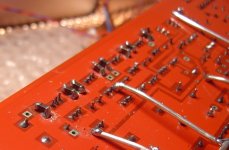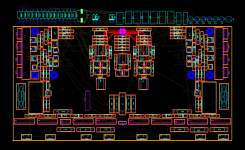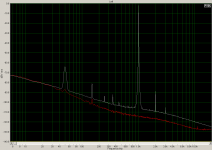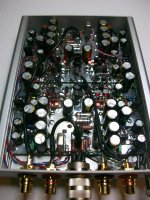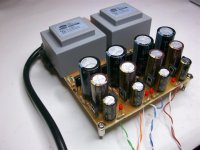I even DC coupled, or do the "blocking caps" be "decoupling caps"?
I would not put a Paradise behind it, rather a shunt feedback RIAA, also with Opamps.
This is Heresy anyway, Opamps in the MPP thread !
One could change the RIAA components in the Paradise for higher value caps and lower value resistors but there is a boundary on how much current the mirrors can drive.
I would not put a Paradise behind it, rather a shunt feedback RIAA, also with Opamps.
This is Heresy anyway, Opamps in the MPP thread !
One could change the RIAA components in the Paradise for higher value caps and lower value resistors but there is a boundary on how much current the mirrors can drive.
Here is how I implemented the emitter caps in the paradise R1. Not my most beautiful soldering work, but does the job...
How to do it: Scratch away the solder-stop from the ground plane, put solder there, put the caps in (touching the resistor wires), soldered on the GND side first then on the other side. So the caps are effectively from VPLUS or VMINUS to GND.
How to do it: Scratch away the solder-stop from the ground plane, put solder there, put the caps in (touching the resistor wires), soldered on the GND side first then on the other side. So the caps are effectively from VPLUS or VMINUS to GND.
Attachments
Ahhh, that one 'Figure 7. Small Signal Frequency Response for Various Gains', the man at the lab here (ATL) call it a 'sbump'
It not exactly my opinion but who am i ?articles
Thanks for that one, I do like opamps, attached a picture of my 'current work in progress'.
Attachments
What is it ?
It is 'a bump'
Thanks Alfred. There is a package to you on the way where you can do the magic again.
Is that your new 1000W amplifier Frans ?
Yes, but about half of that bridged in 2 Ohms
Voila ! Transimpedance Pre-Pre direct at arm base. WOW, that is the deal. The gain in clarity and transparency is amasing and absolutely no hum !
Nice job... I wonder if what it should sound like if done with discrete jefts
Sure, with discrete there is some "air" to get an even better sound but then we loose the advantage of extreme compactness. Objectively the ADA4898 is pretty damn good.
A circuit so fast and low in distortion is very hard to make discrete.
The sound is very "controlled" whereas a discrete circuit has some potential to sound more "free". It is hard to put it in words. Also the ADA4898 has 0.9nV/qHz of noise with a very low 1/F corner. That can be beaten with a discrete circuit , 0,3nV/qHz is more or less the limit , ca.9dB better, but maybe with a higher 1/F. Subjectively the noise of the ADA4898 is kind of "benign" and very pure, something also hard to get with discrete in character without tremendous effort in noise screening. I wish there would be discrete transistors with the quality of the on chip ones in the ADA.
A circuit so fast and low in distortion is very hard to make discrete.
The sound is very "controlled" whereas a discrete circuit has some potential to sound more "free". It is hard to put it in words. Also the ADA4898 has 0.9nV/qHz of noise with a very low 1/F corner. That can be beaten with a discrete circuit , 0,3nV/qHz is more or less the limit , ca.9dB better, but maybe with a higher 1/F. Subjectively the noise of the ADA4898 is kind of "benign" and very pure, something also hard to get with discrete in character without tremendous effort in noise screening. I wish there would be discrete transistors with the quality of the on chip ones in the ADA.
Hi guys,
glad to see you are making progress with paradise and all the fuss is back to this thread
I dropped by to post my final build of Joachims naked truth. Attached is a couple of pic's which should be self explanatory. I decided on coupling cap vs. servo on this one based only on my own subjective listening preference, so maybe just a couple comment's on psu are in place here. I made quite a few shunt regs (salas variations, walt jung etc.) with very good looking measurements, near ideal step responses, low and ultra low output dependences, good noise specs and so on... but nothing had beaten simple cap multiplier + pana FC for my own listening experience. They are (shunts) excellent in simple se aplications like salas ar srpp, where you get big boost on whole audio range, but for this pp stage I felt that sound was just too unnatural. Next there was big disappointment when I went from battery psu to simple transformer psu. Now matter how much I tried to improve regulation, ripple rejection or other parameters there was "something not right". So I got on usual suspects - namely ground loops. I'm quite paranoid about this subject but luckily all my other audio chain is designed by me and I just couldn't find anything wrong with it. So after some puzzling I was left with only one suspect - transformer inter winding capacitance which could theoretically mess things up a little bit. So I convinced my self for n'th time in my life "there is no such a thing as a ground" (thanks to my old prof. of electronics at uni. for this one) and both incoming and returning currents should be treated as equally important. This led to some research on balanced or common mode regulators which brought me to a great thread by ecdesigns which I haven t' followed for couple of years now. PSU that you see in attached schematics is based on his approach with couple of my own brushes (input voltage/peek current limiter). And what a surprise, it's as close to batteries as I could get ! Massive impedance seen by transformer really helps and you could say that ground is "born" right there were it matters - on a stage's ground plain. So this concept is worth investigating IMO. All at all I'm listening to this stage right now in my system and I'm more then happy with it's sound
P.S. Joachim you have a mail.
glad to see you are making progress with paradise and all the fuss is back to this thread
I dropped by to post my final build of Joachims naked truth. Attached is a couple of pic's which should be self explanatory. I decided on coupling cap vs. servo on this one based only on my own subjective listening preference, so maybe just a couple comment's on psu are in place here. I made quite a few shunt regs (salas variations, walt jung etc.) with very good looking measurements, near ideal step responses, low and ultra low output dependences, good noise specs and so on... but nothing had beaten simple cap multiplier + pana FC for my own listening experience. They are (shunts) excellent in simple se aplications like salas ar srpp, where you get big boost on whole audio range, but for this pp stage I felt that sound was just too unnatural. Next there was big disappointment when I went from battery psu to simple transformer psu. Now matter how much I tried to improve regulation, ripple rejection or other parameters there was "something not right". So I got on usual suspects - namely ground loops. I'm quite paranoid about this subject but luckily all my other audio chain is designed by me and I just couldn't find anything wrong with it. So after some puzzling I was left with only one suspect - transformer inter winding capacitance which could theoretically mess things up a little bit. So I convinced my self for n'th time in my life "there is no such a thing as a ground" (thanks to my old prof. of electronics at uni. for this one) and both incoming and returning currents should be treated as equally important. This led to some research on balanced or common mode regulators which brought me to a great thread by ecdesigns which I haven t' followed for couple of years now. PSU that you see in attached schematics is based on his approach with couple of my own brushes (input voltage/peek current limiter). And what a surprise, it's as close to batteries as I could get ! Massive impedance seen by transformer really helps and you could say that ground is "born" right there were it matters - on a stage's ground plain. So this concept is worth investigating IMO. All at all I'm listening to this stage right now in my system and I'm more then happy with it's sound
P.S. Joachim you have a mail.
Attachments
The dual is back ordered everywhere I looked. There are also a few more resistors visible in Joachim's picture. I have been wondering what he uses them for.
So thats 24dB. This opamp even comes in a dual version, so only 7 components needed (opamp, two resistors, 4 blocking caps) - cute!
what would we need to do to the Paradise to reduce the gain accordignly, without changing the RIAA time constants?
Sampler is back ! That made my day. I thought he was on a secret mission to Mars !
The Naked Truth is well dressed i would say so he has being busy and productive as always. Thanks for putting so much energy into this project. It always makes me happy when i see something materialize that started in our heads as thought experiment.
Grufty, i will draw up the circuit of the Transimpedance Pre-Pre.
It is really simple but it performs.
The Naked Truth is well dressed i would say so he has being busy and productive as always. Thanks for putting so much energy into this project. It always makes me happy when i see something materialize that started in our heads as thought experiment.
Grufty, i will draw up the circuit of the Transimpedance Pre-Pre.
It is really simple but it performs.
